Kia Motors Bundle
Can Kia Motors Conquer the Future of Mobility?
Kia Motors is undergoing a dramatic transformation, shifting its focus to electric vehicles (EVs) and purpose-built vehicles (PBVs). From its humble beginnings in South Korea, Kia has evolved into a global automotive powerhouse. This Kia Motors SWOT Analysis offers a deep dive into the company's strategic moves.
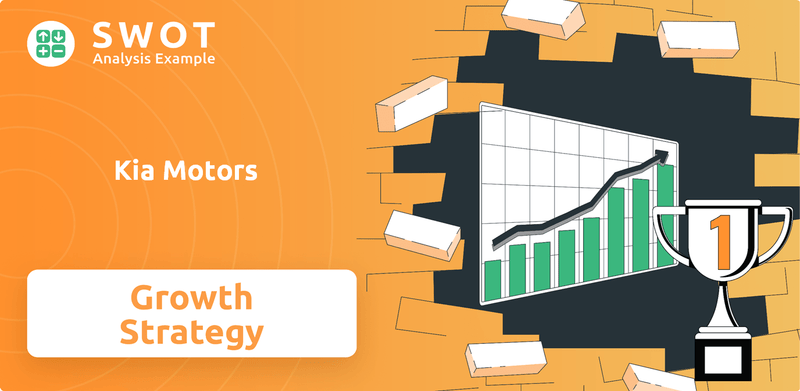
Kia's 'Plan S' initiative is the cornerstone of its strategy, aiming to establish the company as a leader in sustainable mobility. With record-breaking sales in 2024, the Kia Company Analysis reveals a company poised for significant growth. This exploration will delve into Kia's ambitious plans for global expansion, technological advancements, and its financial outlook, providing a comprehensive understanding of its future prospects within the competitive automotive industry, especially focusing on Kia Electric Vehicles.
How Is Kia Motors Expanding Its Reach?
Kia is actively pursuing growth through an aggressive expansion strategy. This involves entering new markets, broadening its product range, and forming strategic alliances. The company's focus is on increasing its global presence, particularly in the electric vehicle (EV) sector, to meet the rising demand for sustainable transportation solutions. This strategic approach is designed to solidify Kia's position in the automotive industry and ensure long-term success.
A key component of Kia's expansion strategy is the growth of its electric vehicle (EV) production network. By 2025, Kia plans to expand its EV production from two facilities in South Korea and China to a global network of eight facilities. This expansion aims to cater to diverse local markets by delivering electric vehicles tailored to regional preferences and accelerating the popularization of Kia's EV lineup. This expansion will enable Kia to better serve regional demands and capitalize on the growing EV market.
Kia's strategic initiatives are designed to capitalize on emerging opportunities and strengthen its position in the global automotive market. This includes expanding production capacity, introducing new models, and investing in innovative technologies. These efforts are aimed at enhancing Kia's competitive advantage and ensuring its long-term sustainability. For more insights, you can explore the Revenue Streams & Business Model of Kia Motors.
Kia is significantly increasing its electric vehicle (EV) production capacity. By 2025, the company aims to have a global network of eight EV production facilities, up from two in 2024. This expansion will enable Kia to meet the growing demand for electric vehicles worldwide and cater to regional preferences.
In 2025, Kia plans to launch five new models, one product enhancement, and three derivatives. This includes the Tasman pickup truck, targeting 80,000 units annually and a 6% market share outside North America. In the U.S., a dedicated electric pickup is planned, aiming for 90,000 units and a 7% market share.
Kia is investing heavily in its Platform Beyond Vehicle (PBV) business. The goal is to sell 250,000 PBVs annually by 2030. The PV5 is expected to enter mass production in 2025, followed by the PV7 in 2027 and PV9 in 2029. These modular vehicles will revolutionize the mobility industry.
Kia is expanding its mobility solutions with 'Kia Drive' in Europe, launched in September 2024. The company is also increasing its hybrid lineup, aiming for nearly one million hybrid sales by 2030, doubling the 490,000 units expected in 2025. Production capacity is also being increased.
Kia is actively increasing its production capacity to meet growing demand. This includes expanding its India plant to 430,000 units by mid-2024. Kia Georgia began assembly of the all-electric 2025 EV9 in May 2024, representing a $200 million investment and nearly 200 new jobs. The EV6 also joined the production line in November 2024, following a $217 million expansion.
- The expansion of the EV production network is a key element of Kia's Kia Motors Growth Strategy.
- The introduction of new models and derivatives will strengthen Kia's product portfolio.
- Investments in PBVs and mobility solutions position Kia for future industry trends.
- Increasing production capacity and strategic investments showcase Kia's commitment to Kia Future Prospects.
Kia Motors SWOT Analysis
- Complete SWOT Breakdown
- Fully Customizable
- Editable in Excel & Word
- Professional Formatting
- Investor-Ready Format
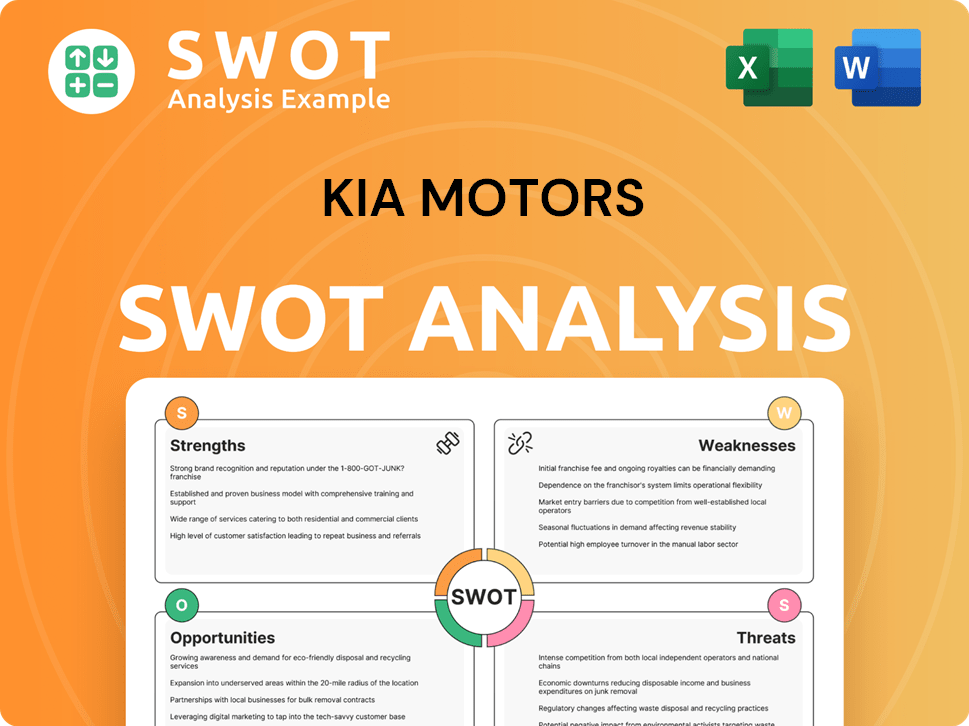
How Does Kia Motors Invest in Innovation?
The growth trajectory of the company is significantly shaped by its innovation and technology strategy, particularly through its 'Plan S' roadmap. This strategic approach focuses on leading the electrification era, expanding EV and hybrid lineups, and integrating advanced technologies to maintain a competitive edge. These initiatives are crucial for driving future growth and solidifying its position in the global automotive market.
The company's commitment to innovation is underscored by substantial investments in research and development, aimed at supporting its transformation. This involves not only the development of new electric vehicles but also the integration of cutting-edge technologies, digital transformation, and sustainability initiatives. These efforts are designed to meet evolving customer needs and preferences.
As the automotive industry evolves, the company's focus on innovation and technology is critical for maintaining its competitive advantage. This includes not only the development of new electric vehicles but also the integration of cutting-edge technologies, digital transformation, and sustainability initiatives. These efforts are designed to meet evolving customer needs and preferences.
The company plans to introduce 15 EV models by 2030, aiming for 1.6 million annual EV sales by the same year. This includes the launch of new volume models such as the EV2, EV3, EV4, and EV5. This aggressive strategy aims to position the company as a leader in the electric vehicle market.
The company plans to invest a total of KRW 42 trillion (approximately $30.8 billion USD) from 2025 to 2029. Of this, KRW 19 trillion will be allocated to future business areas, including electrification, Software Defined Vehicles (SDVs), robotics, and Advanced Air Mobility (AAM). This significant investment underscores the company's commitment to innovation and technological advancement.
The company's PBV (Purpose Built Vehicle) business, unveiled at CES 2024, is a key pillar of its strategy. These vehicles will combine fit-for-purpose EVs with advanced software solutions based on Hyundai Motor Group's software-to-everything (SDx) strategy. These will evolve into AI-based mobility platforms.
The company is enhancing vehicle convenience and performance through Over-the-Air (OTA) update capabilities. This involves leveraging next-generation vehicle architecture, high-performance central computers, and integrated operating systems. This enhances the user experience and keeps vehicles up-to-date.
The company aims to achieve carbon neutrality by 2045 and power all global production bases with renewable energy by 2040, aligning with the RE100 initiative. The company is also collaborating with organizations like The Ocean Cleanup to recycle marine plastic waste into new vehicle accessories for models like the EV3.
The company aims to expand the use of recycled plastic in its vehicles to over 20% by 2030. The company also plans to incorporate hydrogen technology into its manufacturing process and release hydrogen fuel cell electric vehicles (FCEVs) by 2028. This demonstrates a commitment to sustainable practices.
The company's innovation and technology strategy is multifaceted, encompassing electrification, digital transformation, and sustainability. This approach is designed to drive future growth and maintain a competitive edge in the global automotive market. The company's focus on electric vehicles, as detailed in Brief History of Kia Motors, is a central element of its strategy.
- Electrification: Aggressively expanding its EV and hybrid lineups with a target of 15 EV models by 2030.
- R&D Investment: Significant investments in future technologies, including electrification, SDVs, robotics, and AAM.
- PBV Business: Developing purpose-built vehicles with advanced software solutions.
- Digital Transformation: Enhancing vehicle capabilities through OTA updates.
- Sustainability: Committing to carbon neutrality and using recycled materials.
Kia Motors PESTLE Analysis
- Covers All 6 PESTLE Categories
- No Research Needed – Save Hours of Work
- Built by Experts, Trusted by Consultants
- Instant Download, Ready to Use
- 100% Editable, Fully Customizable
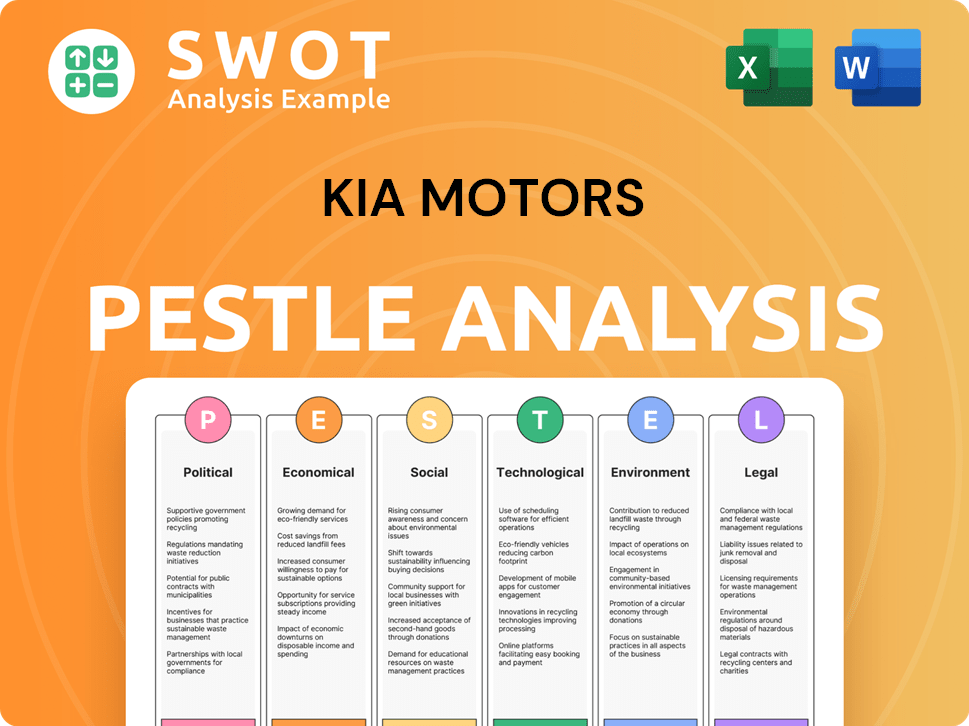
What Is Kia Motors’s Growth Forecast?
Kia Corporation's financial trajectory reflects a strong commitment to growth and innovation within the automotive industry. The company has demonstrated robust financial performance, setting ambitious targets for the future, particularly in the rapidly evolving electric vehicle (EV) market. This strategic focus is underpinned by significant investments in new technologies and global expansion initiatives.
In 2024, Kia achieved record-breaking annual global sales and revenue, highlighting its successful strategies. The company's financial outlook for 2025 and beyond indicates a continued focus on profitability and market share expansion. Kia's strategic investments and partnerships are designed to enhance its competitive position and drive long-term value creation.
Kia's financial strategy is geared towards achieving sustainable growth and maximizing shareholder value. The company's plans include significant investments in future businesses such as electrification, SDVs, robotics, and Advanced Air Mobility (AAM). These investments are expected to drive revenue growth and improve profitability over the coming years.
Kia achieved record-high annual global sales of 3.1 million units in 2024. The annual revenue reached KRW 107.45 trillion (approximately $79.3 billion USD), marking a 7.7% increase from the previous year. Operating profit for 2024 climbed to KRW 12.67 trillion, up 9.1% compared to 2023.
Kia's operating profit margin for 2024 was 11.8%. This reflects the company's efficient cost management and strong sales performance. Kia's ability to maintain a high operating profit margin is a key indicator of its financial health and operational efficiency.
For 2025, Kia has set a global sales target of 3.22 million units, representing a 4.1% increase year-over-year. The company aims to achieve revenue of KRW 112.5 trillion (approximately $82.8 billion USD) in 2025. This growth is driven by the expanding Competitors Landscape of Kia Motors and global market demand.
Kia aims for an operating profit of KRW 12.4 trillion in 2025. The company targets an operating profit margin of 11% for the same year. This reflects Kia's focus on maintaining profitability while investing in future growth areas.
In the first quarter of 2025, Kia reported its highest-ever quarterly revenue of KRW 28.02 trillion, a 6.9% increase year-over-year. While operating profit for Q1 2025 decreased by 12.2% to KRW 3.01 trillion, the company maintained an operating profit margin of 10.7%, marking its tenth consecutive quarter with an operating profit margin over 10%.
- The strong revenue growth indicates robust demand and effective sales strategies.
- The consistent operating profit margin demonstrates efficient cost management and operational excellence.
- These results highlight Kia's resilience and ability to navigate market challenges.
- The focus on maintaining profitability is a key element of Kia's financial strategy.
Kia aims for annual revenue growth of over 10%, an operating profit margin of over 10%, and a return on equity (ROE) of over 15%. These targets reflect Kia's commitment to sustainable financial performance and shareholder value creation.
By 2030, Kia aims for global sales of 4.19 million units, including 2.33 million hybrid and fully electric vehicles. The company projects to achieve KRW 170 trillion in revenue and an operating profit of KRW 18 trillion, maintaining an operating profit margin of over 10%. This strategic shift towards EVs is crucial for Kia's future prospects.
Kia plans to invest a total of KRW 42 trillion from 2025 to 2029. Of this, KRW 19 trillion will be specifically allocated to future businesses like electrification, SDVs, robotics, and Advanced Air Mobility (AAM). These investments are essential for Kia's long-term growth strategy.
Kia aims to expand its Total Shareholder Return (TSR) up to 35% in 2025, from 33.3% in 2024. This demonstrates Kia's commitment to creating value for its shareholders through strategic financial management and operational excellence.
Kia's strategic focus includes expanding its market share in key regions, increasing its electric vehicle sales, and investing in innovative technologies. These initiatives are designed to enhance Kia's competitive advantage and drive sustainable growth. The company's commitment to these areas is a key part of its Kia Motors growth strategy.
Kia's financial outlook is positive, with ambitious targets for revenue growth, profitability, and market expansion. The company's strategic investments in future businesses and its focus on electric vehicles position it well for long-term success. Kia's financial performance and outlook highlight its potential in the global automotive market.
Kia Motors Business Model Canvas
- Complete 9-Block Business Model Canvas
- Effortlessly Communicate Your Business Strategy
- Investor-Ready BMC Format
- 100% Editable and Customizable
- Clear and Structured Layout
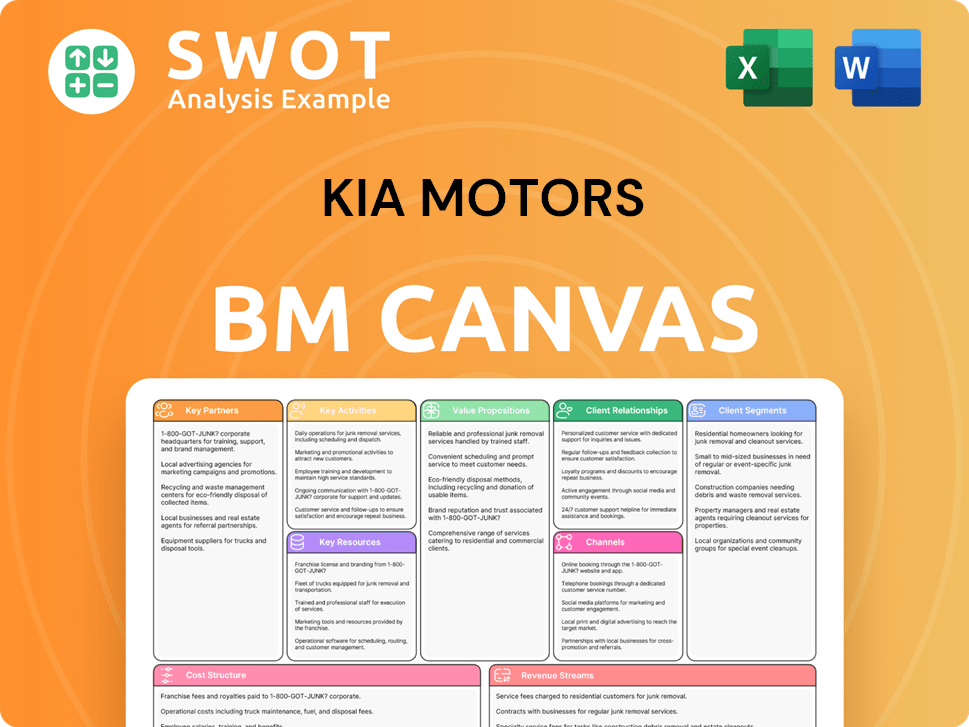
What Risks Could Slow Kia Motors’s Growth?
The ambitious growth of Kia Motors faces several significant challenges. The company must navigate intense market competition, especially in the rapidly evolving electric vehicle (EV) sector. Additionally, regulatory changes and supply chain vulnerabilities pose ongoing risks.
Technological advancements and internal resource constraints further complicate Kia's expansion plans. Despite these hurdles, Kia is implementing strategic measures to mitigate risks and capitalize on opportunities. These include diversifying its product portfolio and strengthening its ESG management.
Kia's financial performance and future are closely tied to its ability to adapt to market dynamics and overcome these obstacles. For a deeper understanding of the company's marketing approaches, consider exploring the Marketing Strategy of Kia Motors.
The automotive industry is highly competitive, with established automakers and new entrants vying for market share. Kia faces pressure from competitors with expanding EV offerings. Adapting to changing consumer preferences and technological advancements is crucial for maintaining a competitive edge in the Kia Motors growth strategy.
Changes in emissions standards and tariffs can impact Kia's profitability and operational strategies. For instance, tariffs imposed by the U.S. can affect the company's financial performance. Kia actively adjusts its production systems to manage these regulatory challenges.
Supply chain disruptions pose a constant threat to production and delivery timelines. Expanding local EV production in key regions aims to optimize the supply chain. Kia's global expansion strategy includes efforts to enhance supply chain resilience.
Rapid technological advancements require continuous investment in research and development. Kia is heavily investing in software-defined vehicles (SDVs), robotics, and advanced air mobility (AAM). The pace of technological adoption by consumers is unpredictable, posing a risk.
Internal resource constraints, such as skilled labor for EV production and software development, can impede growth. Addressing these limitations is crucial for achieving Kia's future prospects. Kia is working to build a robust workforce capable of supporting its strategic initiatives.
Fluctuating demand for EVs presents a challenge, prompting Kia to strengthen its hybrid electric vehicle (HEV) lineup. This strategic move helps manage market uncertainties. Kia's ability to adapt to changing consumer demand is essential for its long-term success.
Kia's 'Plan S' strategy proactively addresses uncertainties in the mobility industry. The company diversifies its product portfolio, including ICE, hybrid, plug-in hybrid, and fully electric models. Kia aims to strengthen its ESG management system for suppliers to build sustainable supply chains. The company's strategic partnerships and collaborations are also vital.
Despite record revenue, Kia experienced a decline in operating profit in Q1 2025, partially due to increased dealer incentives. This highlights the need for efficient incentive strategies to maintain profitability. Kia's financial performance and outlook are closely monitored to ensure sustainable growth. Kia's long-term vision and goals are ambitious.
Kia Motors Porter's Five Forces Analysis
- Covers All 5 Competitive Forces in Detail
- Structured for Consultants, Students, and Founders
- 100% Editable in Microsoft Word & Excel
- Instant Digital Download – Use Immediately
- Compatible with Mac & PC – Fully Unlocked
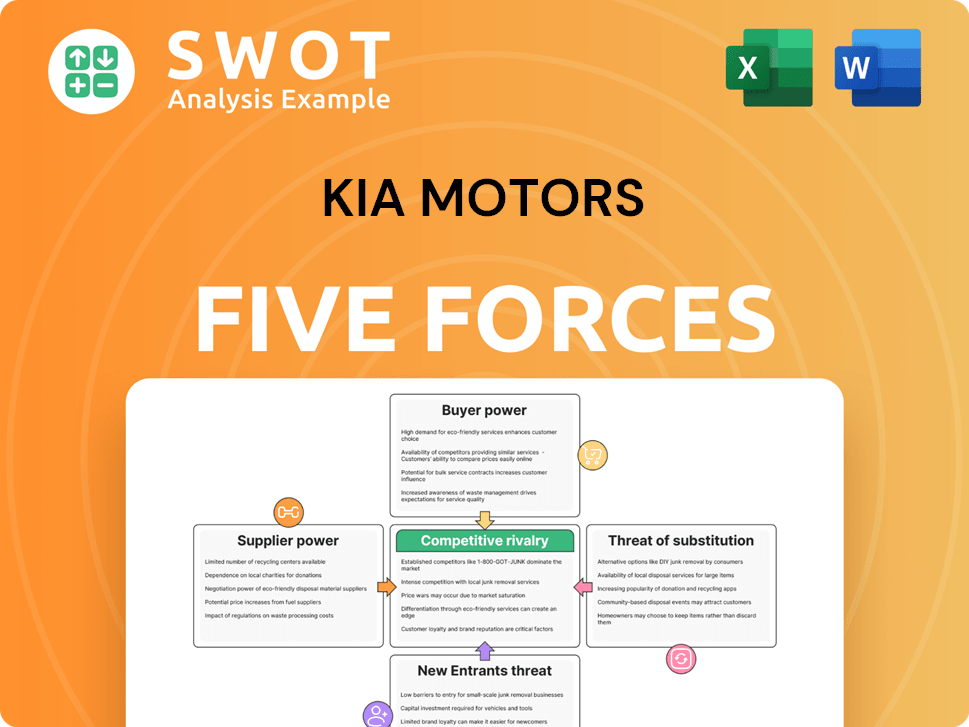
Related Blogs
- What are Mission Vision & Core Values of Kia Motors Company?
- What is Competitive Landscape of Kia Motors Company?
- How Does Kia Motors Company Work?
- What is Sales and Marketing Strategy of Kia Motors Company?
- What is Brief History of Kia Motors Company?
- Who Owns Kia Motors Company?
- What is Customer Demographics and Target Market of Kia Motors Company?
Disclaimer
All information, articles, and product details provided on this website are for general informational and educational purposes only. We do not claim any ownership over, nor do we intend to infringe upon, any trademarks, copyrights, logos, brand names, or other intellectual property mentioned or depicted on this site. Such intellectual property remains the property of its respective owners, and any references here are made solely for identification or informational purposes, without implying any affiliation, endorsement, or partnership.
We make no representations or warranties, express or implied, regarding the accuracy, completeness, or suitability of any content or products presented. Nothing on this website should be construed as legal, tax, investment, financial, medical, or other professional advice. In addition, no part of this site—including articles or product references—constitutes a solicitation, recommendation, endorsement, advertisement, or offer to buy or sell any securities, franchises, or other financial instruments, particularly in jurisdictions where such activity would be unlawful.
All content is of a general nature and may not address the specific circumstances of any individual or entity. It is not a substitute for professional advice or services. Any actions you take based on the information provided here are strictly at your own risk. You accept full responsibility for any decisions or outcomes arising from your use of this website and agree to release us from any liability in connection with your use of, or reliance upon, the content or products found herein.